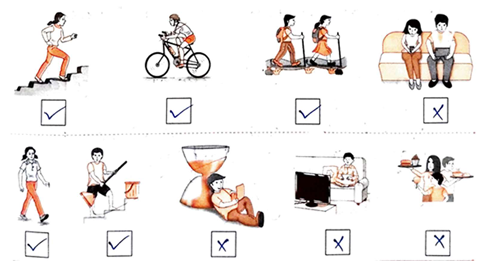1 Being Active
Measure your physical activity!
| Physical activity | Sedentary behaviour (sitting, sleeping, reading, writing, etc.) | Moderate to vigorous intensity (standing, walking, climbing stairs, cycling, swimming, dancing, household chores, etc.) | Vigorous intensity (Plyometric exercise, aerobics, sports, cycling, weight training, running, etc.) |
|---|---|---|---|
| How much time spent each day? | 13 Hours | 45 Minutes | 30 Minutes |
| Recomm-endations by WHO (World Health Organi-zation) on physical activity and sedentary behaviour |
(1) Children between the ages of 5 and 17 years old should at least do an average of 60 minutes (1 hour) of moderate to vigorous intensity physical activity per day. (2) Aerobics should be included in daily physical activity. (3) Vigorous intensity aerobic activities, as well as those that strengthen muscles and bones, should be incorporated at least 3 days a week. |
||
| Action plan as per the recomme-ndations |
(1) Check if your physical activity is as per the recommendations above. (2) Minimize the time spent being sedentary. (3) Limit the amount of recreational screen time, that is mobile, computer, TV, video games, etc. (4) Write down some measures to increase physical activity. (5) Change body action while you study in a half hour time. (6) Don’t do exercise fastly and above limit. (7) Take good sleep to be fresh daily. |
||
Exercises
1 (A) Complete the following statements by choosing the ,correct words from
the brackets :(inactivity, changing, pyramid, fewer)
(1)Keep changing the type of work or study to maintain your activity level throughout the day.
(2) When in the waking state c behaviour (sitting, reclining or lying posture) of a person, 1.5 METs or fewer calories are expended, it is called a Sedentary behaviour.
(3) If there is less physical activity for a sustained period of time, the effects of physical inactivity begin to show on the body over time.
(4) The five-step physical activity pyramid can incorporate into your routine.
Q. 1 (B) Match the correct pairs:
| Group ‘A’ | Answers | Group ‘B’ |
|---|---|---|
| (1) Vigorous intensity activity | Active lifestyle | (a) Writing |
| (2) Exercise | Serotonin chemical | (b) Active lifestyle |
| (3) Sedentary behaviour | Writing | (c) Serotonin chemical |
| (4) Physical activity pyramid | Dancing | (d) Dancing |
Q. 2. Tick the dos ✔ and don’ts ✖ to increase physical activity :

Q. 3.Answer the following questions in one sentence :
(1) Write the definition of physical activity .
Ans.
When calories are expanded while doing any body movement using muscles it is called physical Activity.
(2) What is the minimum amount of time per day of moderate to vigorous activity required for staying physically active ?
Ans.
Doing at least 60 minutes of moderate to vigorous physical activity everyday , keep staying physically active.
(3) Write two vigorous physical activities that you do regularly.
Ans.
(i) Running
(ii) Cycling
(4) Write any two adverse effects of physical inactivity.
Ans.
(i) Obesity ,
(ii) Back pain , joint pain.
4. Answer in brief :
(1)Write the benefits of being physically active.
Ans.
(i) There is discipline in personal life . Improves quality of life.
(ii) Increase muscular and joint strength .
(iii) Increases memory and confidence.
(2) Write in detailwhat changes you would make in your daily life to reduce physical inactivity.
Ans.
(i) Take short breaks and stretch every hour .
(ii) Opt stairs , walk to nearby places , and park further .
(iii) Fit in quick home workouts like squats or yoga .